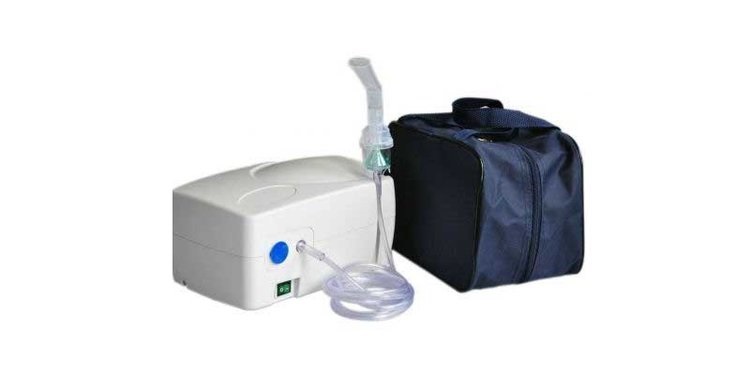Nebulizers
Nebulizers are drug delivery devices that convert liquid medications into aerosols (mist) which are a suspension of liquid particles in gas. In the nebulizers the drugs appear as mist which is inhaled by the patient and delivered directly to the lungs. Nebulizers are used for patients with respiratory problems such as asthma, COPD, cystic fibrosis etc. Nebulizers give better and longer relief as compared to inhalers. The drugs that are commonly delivered through nebulizers are bronchodilators and corticosteroids. When numerous drugs are to be administered using nebulizers, the order in which they are taken is to be considered. For instance, in patients who are required to take both bronchodilators and corticosteroids, bronchodilators should be taken first which will widen the constricted airways for efficient delivery of corticosteroids.
There are two types of nebulizer available for consumers, table top or portable nebulizes. Table top nebulizers are heavy and they are not meant to be carried around. They need an electric outlet for operation. Portable nebulizers on the other hand can be carried around easily and are light weight devices. Portable nebulizers offer many benefits compared to table top nebulizers.
Portable nebulizers
Portable nebulizers are hand held devices that are designed to deliver medications when patients are both outside and inside their homes. They are preferred by patients who have a busy lifestyle and cannot reach home on time to take their medications through table top nebulizers. They are also ideal for people who need to travel a lot as part of their jobs. The reason why most people do not regularly use Portable Nebulizers is because they are expensive and not covered by Medicare Or Medicaid.

Parts of a portable nebulizer
Similar to table top nebulizer the basic parts of the portable nebulizers are:
· A system to convert the liquid drug into mist,
· A nebulizer cup or receptacle to hold the medication
· A mouth piece or a mask to inhale the drug
The drugs placed in the receptacle are inhaled by the patient in the form of a mist which directly reaches the lungs.
Types of portable nebulizers
There are various models of nebulizers which differ in the way they generate the aerosol form of the drug. The most common portable nebulizers come as ultrasonic nebulizers and jet nebulizers.
Ultrasonic nebulizers
In this type of nebulizers ultrasonic waves are generated by an electronic oscillator which creates vibrations in a vibrating element placed in contact with the liquid drug. The high frequency vibration of the vibrating element converts the liquid drug into mist. The mist is then inhaled by the patients and it is then directly delivered to their lungs. These nebulizers are only available as portable models. The disadvantage in this model is that the medication gets heated when it gets converted into an aerosol. This is not suitable for thermo labile drugs.
Jet nebulizers
They are also called atomizers. These nebulizers have a compressor that pass compressed air or oxygen into the liquid drug at high velocity which converts the liquid drug into a mist. The patient then inhales the aerosol. These nebulizers are available both as tabletop and portable models. The disadvantage in this model is that it makes noise while working
Vibrating mesh technology nebulizers
These nebulizers were introduced in 2005. In this model of nebulizers, a mesh bearing laser drilled holes vibrates on top of the liquid reservoir. This causes the liquid drug to escape through the holes as mist. In nebulizers using vibration mesh technology the liquid drug does not get heated like the ultrasonic nebulizers and there is formation of less liquid waste. They are also silent devices as they do not make much noise while operating. However, nebulizers using vibrating mesh technology are typically.
How do portable nebulizers work?
The required quantity of the drug is placed in the nebulizer cup. The aerosol generating device, mouth piece or mask and the nebulizer cup are all connected by tubing. When machine is turned on, the drug appears in the form of mist. The entire dose of medication is then inhaled by the patient through the mouth piece or mask and the process takes about 5 -10 minutes depending upon the type of nebulizer used and the medicine inhaled. Some patients complain of headache, tremors and rapid heartbeat during the process. If these symptoms occur rest for 5 mins and then resume the process. If the symptoms persist inform your doctor.
How to maintain a portable nebulizer?
To obtain optimum results the nebulizer should be properly cleaned and the parts such as air filters, mouth piece, mask, and tubing should be replaced regularly.
1. Clean the parts of the nebulizer regularly as directed by the manufacturer. Avoid dust and other particle buildup on the nebulizer which might decrease its efficiency to function.
2. Disposable masks should be discarded after using for 5-7 times while the regular masks can be used for 6 months. Follow the manufacturer’s instructions and use the mask only for the time specified.
3. Check and change your air filter frequently as a dirty filter will make your nebulizer wear down fast.
4. Clean the outside of the tubing of your nebulizer and look out for cracks or leaks in the tubing.
5. Always have extra air filters, masks and tubes in hand for emergencies.
Disposable nebulizer sets
Disposable nebulizer sets are available that reduce the risk of infections and require less maintenance. They are ideal for traveling and they can be taken along with portable nebulizers. They come in handy when cleaning the regular nebulizer set is inconvenient. They can also be very useful for children when they are going for camps or field trips.
Advantages of portable nebulizers
The major advantage of portable nebulizer is that it can be used anywhere both outside and inside the house. It does not restrict your freedom to follow your routine schedule as you can carry it anywhere you go.
1. Portable nebulizers do not need an electric outlet for power supply. Some of them use rechargeable batteries while others use disposable batteries. They can also be recharged in cars if they come with car power adapters.
2. Portable nebulizers are light weight and compact compared to table top nebulizers. They can be easily placed in a bag or a purse so it’s easy to carry them around.
3. Portable nebulizers are very beneficial for patients suffering from severe asthma. These patients carry inhalers when they leave their homes for work, other daily chores and when they travel. These nebulizers are an effective choice for these patients as they deliver the drugs directly into the lungs giving relief for a longer duration.
4. Some patients with COPD, severe asthma or allergies are required to take several medications. When these patients travel, a portable nebulizer will offer better benefits compared to inhalers. Portable nebulizers can more efficiently deliver bronchodilators and corticosteroids in these patients as the drugs are delivered directly into the lungs. The patients do not have to carry different types of inhalers and moreover portable nebulizers provide better relief than inhalers. These nebulizers will also have a positive improvement on the quality of life of the patients.
Portable nebulizers are ideal for infants and children because they are light weight and can be carried around unlike tabletop nebulizers. They can be a good choice especially for children as they don’t have to be restrained inside their homes for their medication requirements. They also get better and longer relief from portable nebulizers when compared to inhalers. The use of portable nebulizers definitely improves the quality of life of children suffering from respiratory problems.






Leave a Reply